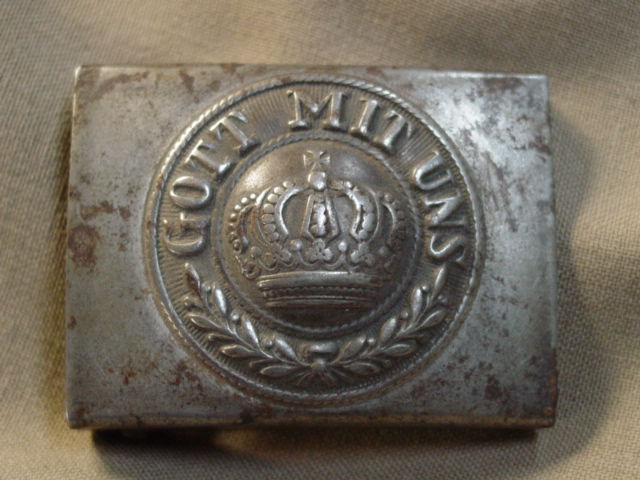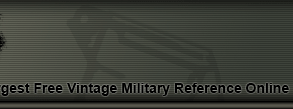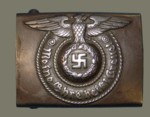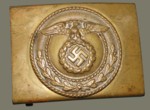|
WWI GERMAN BUCKLE - ARMY
The German army that fought in World War I was not in fact a single, unitary army. All the
monarchies as a part of the German empire had its own armies. Since the unification of Germany
in January 1871 most of them were under prussian command but, however, wear its own style of
uniforms and insignias. The four German kingdoms that existed since the Napoleonic era - Bavaria,
Prussia, Saxony and Württemberg - of course had its own armies until the end of WW I. The
commander in chief in peacetime of each of these armies was the King. Prussia had the largest
army of the four. After the unification and the formation of the German Empire, the Prussian army
became the nucleus of the Armies of the German Empire (Deutsches Reichsheer). After the
declaration of war, the emperor became the commander-in-chief of all the armed forces. By 1914
the German army fielded 50 active divisions and 48 Reserve-Divisions - until 1918 251 divisions
had been created.
This is a WWI German belt buckle. As used by the Army during the war. Of steel construction.
The design consisted of a smooth surface. Two ropes, one inside the other, form a circle in the
center. A crown is placed inside the inner most circle. The space created between the two ropes
is divided in two. The upper section has tightly placed ribbing. The bottom part contains a
wreath. Very nice detailing.
The same basic pattern was employed during WWII. The crown was replaced by an eagle holding a swastika.

|
This page is a recognition and identification guide for WWII German belt buckles. Multiple detailed
photos of specific samples are provided. Descriptions point out clearly defined aspects that should be
noted when inspecting a Third reich belt buckle.
The belt buckles of the Third Reich came in a variety of designs. There were over 100
different types developed. Even the non-military belt buckles often displayed the
swastika as a means to show support of the Nazi party.
The high quality and intricate designs have made the German belt buckles of World
War Two a desirable military collectible. this information is brought to you courtesy of
MilitaryItems.com
|
|
This is a view of the back of the German buckle. The catch is of the "Square" type. It is spot
welded to the body of the buckle. There are no markings in this example. That is correct,
some buckles were marked while others were not.
The prongs are attached to a cylindrical structure which swivels over 180 degrees. This allows
the buckle to be attached to the belt.
The belt buckles of the Third Reich came in a variety of designs. There were over 100
different types developed. Even the non-military belt buckles often displayed the
swastika as a means to show support of the Nazi party.
The high quality and intricate designs have made the German belt buckles of World
War Two a desirable military collectible.

This belt buckle may currently be reproduced.
It is becoming more difficult to be able to tell the fake ones from the real ones because the quality
of the reproductions is improving. The collector must become familiarized with the construction style
and materials employed in the manufacturing of this buckle. Attention to the details is critical in
order to be able to determine the authenticity of the belt buckle.
If you have an interest is seeing other belt buckles of the Third Reich, you can do so by going
to our WWII German Belt Buckles
identification guide. Where we cover Heer (Army), Navy (Kriegsmarine), Air Force (Luftwaffe),
political and civilian buckles.
|











